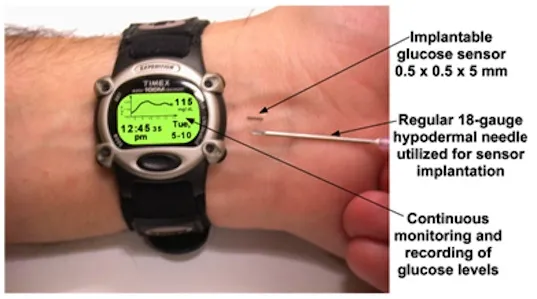A tiny microchip will prevent diabetics from having to prick to control glucose
The American Biorasis laboratory has patented a tiny microchip capable of continuing continuous blood glucose concentration, and sending radio information to an external device.The system, which will enter the clinical phase in just over a year, is called Glucowizzard.
The chip contains a complete chemical laboratory inside, and has a thickness of half a millimeter and a length of just half a centimeter, which facilitates its implementation under the patient's skin through a simple hypodermal needle.The company researchers recommend that it be implanted under the skin of the wrist.Once placed in place, you will begin your task of monitoring glucose levels for a year, after which it must be replaced.The patient must carry a clock -like bracelet, in charge of receiving the radio signals sent by the chip and stores blood readings and shows them on a small LCD screen (liquid crystal).
The wrist device feeds solar cells installed in the chip, firing light pulses through the skin.You can also send the information wirelessly to various devices such as mobile phones, electronic agendas, and even laptops, so that the patient has their vital statistics per day, second to second.
The sensor chip uses an enzyme that releases electrons, whose amount depends on the level of blood glucose.If the readings are too high, the wrist device issues an alert so that the patient takes measures, and can even contact an emergency service.Biorasis researchers also expect to integrate the platform formed by the sensor plus the wrist receptor into various types of insulin dispensers, which at the precise moment would receive a wireless signal.
At the moment, the Glucowizzard platform is being used successfully in laboratory animals, and has shown that it is possible to have diabetes with continued readings. This is not the first attempt of the pharmaceutical industry to achieve an implantable system that measures levelsof glucose, but the previous experiences failed, because it was necessary to cross the skin with electrodes, and in many cases the organism rejected the implant.Both problems have been solved with this microchip that sends information through radio waves, and that is covered with a layer that prevents rejection.
Glasses capable of measuring glucose concentration
Another research, less advanced but equally promising, is the one directed by Professor Jin Zhang, a biochemical engineer from Western Ontario University in Canada.This researcher has developed contact lenses capable of measuring changes in diabetic glucose concentration, and reflecting them through a simple color change.The measurement method, uncertainty, is carried out from the glucose contained in tears.The invention of Professor Zhang, is based on nanoparticles that are embedded in the hydrogel of the lentillas.Diabetes patients who wear them will only have to look periodically in a small hand mirror.
According to the color of the contact lenses, they will know if everything is in order, or if a risk situation is approaching, and to what degree.This investigation has aroused the interest of the Foundation for the Innovation of Canada, which has decided to grant the project a subsidy of $ 210,000.This nanoparticle technology admits various applications in the food industry.A plastic sheet containing nanoparticles sensitive to certain gases or moisture could be used in packagingFood, because with a simple color change it would be a reliable indicator of the food conservation status.
Diabetes is one of the most common diseases of the 21st century.More than 200 million people around the world suffer from it, and when uncontrolled it can have fatal consequences for the body.Hence the importance of knowing blood sugar levels at all times.To do this, diabetics are forced to practice a puncture, usually on a finger, to extract a drop of blood that then place in a reactive strip or in a personal analysis system.In most cases the diabetic must perform this test several times a day to know the evolution of blood glucose concentration.








